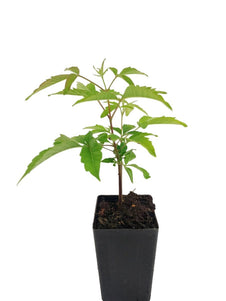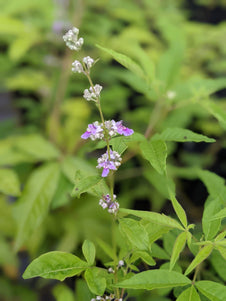





Chinese Vitex
Chinese Vitex

- Low stock - 12 items left
- Inventory on the way

Usually available: October to March
Life cycle: Herbaceous Perennial
Height: 3m
Position: Full sun
Soil preference: Well drained
This is how we pack and send your Herb Plants to all states except TAS & WA
You will receive
- 1 Chinese Vitex Herb Plant in a 50 X 75mm tube - General growing instructions
All of our Herb Plants are grown organically with certified organic potting mixes and fertilizers
Botanical Name: Vitex negundo
Chinese Vitex is a deciduous shrub, growing to 3 meters high and 3 meters wide, although greater height may be achieved in the natural environment. The leaves are digitate, with 3-5 lanceolate leaflets. Each leaflet is 4-10 cm long with the central one being the longest. The leaf edges are serrated and the underside is covered in hairs. The leaves and stems of Chinese Vitex are strongly aromatic, while the flowers have a musk perfume. The numerous blue to white flowers are borne on inflorescences and appear in late spring. The petals vary in length, but extend 6-7cm and they are insect pollinated. The bark is a reddish brown colour and the small fruit is black to purple.
Chinese Vitex may also go by the names Huang Ping, Five Leafed Chaste Tree or Chinese Chaste Tree. It is often found near water and grows naturally in the Himalayas in mixed thickets and wastelands up to 2000 meters and natural slopes from 200-1400 meters. The native habitat extends from tropical East Asia to South West China to the Himalayas. There are many countries in this global region, so there are many languages and different names for Vitex negundo.
Growing Conditions
Chinese Vitex prefers warm sunny positions with a light, well drained soil. Other soil types and poor soils are acceptable, as is moist or drier soil. Some shade may be okay depending on other factors, but full shade will not produce good results. Although, the plant will tolerate temperatures to -10 C, it is best to protect it from cold, drying winds. It is not very hardy in climates similar to cold European winters. The seed should be sown in March or semi hardwood cutting may be taken for propagation.
Medicinal Uses
This plant has a long history of use in traditional medicine and folklore. It is said to be anti-malarial in its action. The main chemical constituents in the leaf juice are; casticin, isoorientin and the essential oil components sabinene, linalool and terpines. To use the plant should be harvested in early summer.
The leaves are astringent, febrifuge, vermifuge, sedative, tonic, anti-bacterial and anti-inflammatory, while the root is also expectorant. Chinese traditional medicine practitioners consider Vitex negundo to be the second most important treatment for bronchitis. The roots and leaves are used as treatments for ringworm, eczema and other skin diseases, liver and spleen disorders as well as back pain and gout. The leaves are useful for treating swelling related to rheumatism. The dried fruit is considered to be vermifuge and was extensively used for intestinal worms. The fruit was also used for treating conditions as varied as angina, colds, cough and burns. When pulped the dry berries may be used in a tincture for relief of limb pain.
Culinary Uses
The seed from Chinese Vitex is occasionally used as a condiment or pepper substitute. It has a bitter taste but when washed the bitterness is removed to some degree. It can then be ground into a powder and used as flavouring. However, it is really considered to be a famine food that was used when nothing else was available. It can be made into a tea using the roots and leaves.
Other Uses
The young stems may be used to weave baskets and make wattles. The leaves are also used to repel insects in grain stores. And the leaves are burnt together with grasses as a fumigant against mosquitos. Chemical extracts from the leaves have been shown to have insecticidal activity. Chinese vitex is also used in mass planting on mountain slopes to help prevent landslides.
All information provided on this website is for informational purposes only. Please seek professional advice before commencing any treatment.





